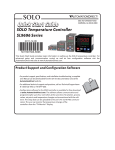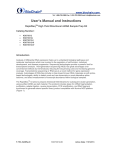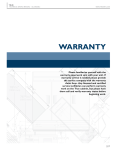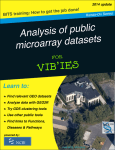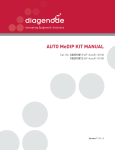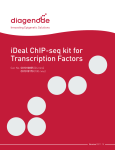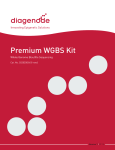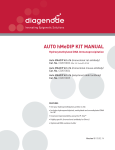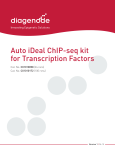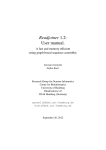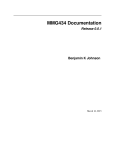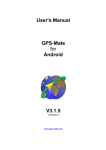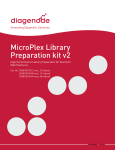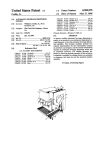Download - Diagenode
Transcript
Premium RRBS kit Reduced Representation Bisulfite Sequencing Cat. No. C02030032 (24 rxns) C02030033 (96 rxns) Version 1 I 04.15 Contacts DIAGENODE HEADQUARTERS Diagenode s.a. BELGIUM | EUROPE LIEGE SCIENCE PARK Rue Bois Saint-Jean, 3 4102 Seraing - Belgium Tel: +32 4 364 20 50 Fax: +32 4 364 20 51 [email protected] [email protected] Diagenode Inc. USA | NORTH AMERICA 400 Morris Avenue, Suite #101 Denville, NJ 07834 Tel: +1 862 209-4680 Fax: +1 862 209-4681 [email protected] [email protected] For a complete listing of Diagenode’s international distributors visit: http://www.diagenode.com/company/distributors.php For rest of the world, please contact Diagenode sa. Diagenode website: www.diagenode.com PAGE 3 Content Introduction. . . . . . . . . . . . . . . . . . . . . . . . . . . . . . . . . . . . . . . . . . . . . . . . . . . . . . . . . . . . . . . . . . . . . . . . . . . . . . . . . . . . . . . . . . . . . . . . . . . . . . . . . . . . . . . . . . . . . . . . . . . . . . . . . . . 4 Diagenode’s premium RRBS technology. . . . . . . . . . . . . . . . . . . . . . . . . . . . . . . . . . . . . . . . . . . . . . . . . . . . . . . . . . . . . . . . . . . . . . . . . . . . . . . . . . . . . . . . 4 Kit method overview and time table . . . . . . . . . . . . . . . . . . . . . . . . . . . . . . . . . . . . . . . . . . . . . . . . . . . . . . . . . . . . . . . . . . . . . . . . . . . . . . . . . . . . . . . . . . . . . . 5 Kit materials. . . . . . . . . . . . . . . . . . . . . . . . . . . . . . . . . . . . . . . . . . . . . . . . . . . . . . . . . . . . . . . . . . . . . . . . . . . . . . . . . . . . . . . . . . . . . . . . . . . . . . . . . . . . . . . . . . . . . . . . . . . . . . . . . . 6 Required materials not provided. . . . . . . . . . . . . . . . . . . . . . . . . . . . . . . . . . . . . . . . . . . . . . . . . . . . . . . . . . . . . . . . . . . . . . . . . . . . . . . . . . . . . . . . . . . . . . . . . . . 7 Remarks before starting . . . . . . . . . . . . . . . . . . . . . . . . . . . . . . . . . . . . . . . . . . . . . . . . . . . . . . . . . . . . . . . . . . . . . . . . . . . . . . . . . . . . . . . . . . . . . . . . . . . . . . . . . . . . . . . 8 Protocol. . . . . . . . . . . . . . . . . . . . . . . . . . . . . . . . . . . . . . . . . . . . . . . . . . . . . . . . . . . . . . . . . . . . . . . . . . . . . . . . . . . . . . . . . . . . . . . . . . . . . . . . . . . . . . . . . . . . . . . . . . . . . . . . . . . . . . . . . 9 Step 1. Enzymatic Digestion. . . . . . . . . . . . . . . . . . . . . . . . . . . . . . . . . . . . . . . . . . . . . . . . . . . . . . . . . . . . . . . . . . . . . . . . . . . . . . . . . . . . . . . . . . . . . . . . . . . . . . 9 Step 2. Ends Preparation. . . . . . . . . . . . . . . . . . . . . . . . . . . . . . . . . . . . . . . . . . . . . . . . . . . . . . . . . . . . . . . . . . . . . . . . . . . . . . . . . . . . . . . . . . . . . . . . . . . . . . . . . . 9 Step 3. Adaptor Ligation and Size Selection. . . . . . . . . . . . . . . . . . . . . . . . . . . . . . . . . . . . . . . . . . . . . . . . . . . . . . . . . . . . . . . . . . . . . . . . . . . . . 10 Step 4. Quantification and Sample Pooling. . . . . . . . . . . . . . . . . . . . . . . . . . . . . . . . . . . . . . . . . . . . . . . . . . . . . . . . . . . . . . . . . . . . . . . . . . . . . . 11 Step 5. Bisulfite Conversion. . . . . . . . . . . . . . . . . . . . . . . . . . . . . . . . . . . . . . . . . . . . . . . . . . . . . . . . . . . . . . . . . . . . . . . . . . . . . . . . . . . . . . . . . . . . . . . . . . . . 14 Step 6. Enrichment PCR, Clean-up and Quality Control. . . . . . . . . . . . . . . . . . . . . . . . . . . . . . . . . . . . . . . . . . . . . . . . . . . . . . . . . . . 15 Sequencing recommendations . . . . . . . . . . . . . . . . . . . . . . . . . . . . . . . . . . . . . . . . . . . . . . . . . . . . . . . . . . . . . . . . . . . . . . . . . . . . . . . . . . . . . . . . . . . . . . . . . . . . . 17 RRBS data analysis recommendations . . . . . . . . . . . . . . . . . . . . . . . . . . . . . . . . . . . . . . . . . . . . . . . . . . . . . . . . . . . . . . . . . . . . . . . . . . . . . . . . . . . . . . . . . 17 www.diagenode.com | PAGE 4 DIAGENODE PREMIUM RRBS KIT USER MANUAL Introduction DNA methylation is a key epigenetic mechanism with important regulatory functions in development and disease. Bisulfite sequencing enables the detection of cytosine methylation at single-base resolution. Nowadays, this method is widely used for targeted gene analysis due to a relatively low price per reaction. However very few researchers perform genome-wide studies, discouraged by the enormous sequencing efforts and corresponding costs. Reduced Representation Bisulfite Sequencing (RRBS) is the best alternative to increase the scale of the analysis cost efficiently. In the initial step of the RRBS protocol, DNA is digested with the restriction enzyme MspI wich recognizes CCGG sites. Thus, all resulting genomic fragments will start and end with a CpG dinucleotide. Due to the biased distribution of CpGs throughout the genome (depicted in Figure 1), MspI digestion followed by size selection enriches for the most CpG-rich regions, including CpG islands. DNA methylation at these regulating regions, which are often located at gene promoters, is most likely to influence gene expression. Thus, RRBS provides a cost-effective method to analyze DNA methylation in the most relevant genomic regions. Figure 1: Distance between neighboring CpGs Diagenode’s Premium RRBS kit offers a complete solution, including reagents for enzymatic digestion, library preparation, bisulfite conversion and amplification. Moreover this protocol requires only very little starting material (100 ng of gDNA is recommended) and is optimized for high throughput and sequencing on Illumina platforms. Since six samples can be pooled together and processed simultaneously, an experiment starting with 96 samples will require handling only 16 tubes for the bisulfite conversion and only 16 sequencing lanes. Handling time, amount of reagents, and the price per sample are thus greatly reduced. Diagenode’s Premium RRBS technology • Positive and negative spike-in controls are included for the monitoring of bisulfite conversion efficiency • Size selection has been optimized to keep small fragments of interest and to remove adaptor dimers, resulting in a better coverage. • The pooling protocol includes a quantification of the samples and a pooling application, available on our website, to help you to choose the groups, depending on the DNA amount and adaptor barcode of each sample • The bisulfite conversion protocol has been improved to decrease DNA degradation while keeping a highly efficient conversion of unmethylated cytosines • The minimum number of amplification cycles needed for each pool is determined to avoid amplification biases. Our MethylTaq Plus enzyme was developed to amplify bisulfite converted DNA with high efficiency, and reduces the number of PCR cycles required. Innovating Epigenetic Solutions PAGE 5 Kit Method Overview and Time Table 1. Enzymatic digestion CH3 5’ 3’ C CGG GGC C C CGG GGC C 3’ 5’ Ch3 2. Ends preparation CH3 CGG AGCC CCGA GGC 3. Adaptor ligation and size selection CH3 TCGG AGCC CCGA GGCT 4. Sample pooling 96 samples 16 pools with 6 samples each 5. Bisulfite conversion CH3 TCGG AGUU UUGA GGUT 6. PCR amplification and clean-up CH3 PCR TCGG AGUU PCR er 1 prim UUGA GGUT er 1 prim NNNNNN NNNNNN TCAA AGTT CCGA GGCT PCR primer 2 Ready for sequencing Figure 2: Reduced Representation Bisulfite Sequencing (RRBS) workflow www.diagenode.com | PAGE 6 DIAGENODE PREMIUM RRBS KIT USER MANUAL Table 1. Premium RRBS protocol overview DAY Incubation times STEP 1 Enzymatic digestion - Preparation of the 96-well plate with all the samples at the right concentration - Enzymatic digestion DAY 1 12 hours (overnight) STEP 2 Ends preparation DAY 2 1 hour STEP 3 Adaptor ligation DAY 2 30 minutes STEP 4 Size selection DAY 2 15 minutes STEP 5 Quantification - qPCR in duplicates DAY 2 2 qPCR runs STEP 6 Pooling - Calculations - Manual pooling - Clean-up to reduce the volumes DAY 3 15 minutes STEP 7 Bisulfite conversion DAY 3 Overnight DAY 4 30 minutes STEP 8 Determination of the optimal cycle number for the enrichment PCR DAY 4 1 qPCR run STEP 9 Enrichment PCR DAY 4 Several PCR runs STEP 10 Clean-up DAY 5 25 minutes Kit Materials The content of the kit is sufficient to perform 24 or 96 RRBS reactions, starting with genomic DNA and finishing with sequencing-ready libraries (Table 2). Store the components at the indicated temperature upon receipt. Table 2. Components supplied with the Premium RRBS kit Description Quantity (x24) Quantity (x96) Storage Restriction Enzyme 35 µL 115 µL -20°C Ends Preparation Enzyme 35 µL 115 µL -20°C Enzyme Buffer 100 µL 335 µL -20°C dNTP Mix 35 µL 115 µL -20°C Unmethylated spike-in control 35 µL 115 µL -20°C Methylated spike-in control 35 µL 115 µL -20°C Adaptor tube strip A 5 µL each 21 µL each -20°C Adaptor tube strip B 5 µL each 21 µL each -20°C Adaptor tube strip C 5 µL each 21 µL each -20°C Adaptor tube strip D 5 µL each 21 µL each -20°C Adaptor tube strip E 5 µL each 21 µL each -20°C Adaptor tube strip F 5 µL each 21 µL each -20°C Ligase 35 µL 115 µL -20°C Ligation Buffer 1.3 mL 4.5 mL -20°C Primer Mix 47 µL 162 µL -20°C 2X MethylTaq Plus Master Mix 113 µL 413 µL -20°C Water 1390 µL 5.5 mL 4°C Resuspension Buffer 820 µL 3.3 mL 4°C BS Conversion Reagent 1 tube 2 tubes Room temperature Innovating Epigenetic Solutions PAGE 7 BS Dilution Buffer 300 µL 600 µL Room temperature BS Solubilization Buffer 790 µL 1580 µL Room temperature BS Reaction Buffer 160 µL 320 µL Room temperature BS Binding Buffer 4.8 mL 12 mL Room temperature BS Wash Buffer w/o ethanol 1.0 mL 2.5 mL Room temperature BS Desulphonation Buffer 1.6 mL 4 mL Room temperature BS Elution Buffer 176 µL 440 µL Room temperature BS Spin Columns 8 columns 20 columns Room temperature BS Collection Tubes 8 tubes 20 tubes Room temperature Table 3. Adaptor tube strips and corresponding barcode adaptors Adaptor tube strips Strip A Strip B Strip C Adaptor ID Index sequences Adaptor tube strips Adaptor ID Index sequences 17 GTAGAG 37 CGGAAT 24 GGTAGC 38 CTAGCT Strip D 26 ATGAGC 39 CTATAC 28 CAAAAG 40 CTCAGA 29 CAACTA 41 GCGCTA 30 CACCGG 31 CACGAT Strip E 42 TAATCG 43 TACAGC 32 CACTCA 44 TATAAT 33 CAGGCG 45 TCATTC 34 CATGGC 46 TCCCGA 35 CATTTT 47 TCGAAG 36 CCAACA 48 TCGGCA Strip F Required Materials Not Provided • Gloves to wear at all steps • Autoclaved tips • Nuclease-free 1.5 mL tubes • Nuclease-free 15 mL tubes • 96-well plates and 96-well qPCR plates • Multichannel pipettes (12 channels) • 12-tube strips • Racks for 0.2 mL tube strips • Centrifuge for 0.2 mL tube strips • Thermocycler and qPCR thermocycler • qPCR reagents • Centrifuge for 96-well plates • Centrifuge for 1.5 and 2 mL tubes • 96 well plate magnetic rack • DiaMag1.5 ml – magnectic rack (Diagenode, Cat. No. B04000003) • AMPure® XP Beads (Beckman Coulter, Inc. #A63881) • 100% ethanol • Nuclease-free water www.diagenode.com | PAGE 8 DIAGENODE PREMIUM RRBS KIT USER MANUAL Equipments required for quality control: • Fluorescence-based assay for DNA concentration measurement, e.g. the Qubit High Sensitivity assay (Life Technologies #Q32851) • Library analysis assay such as Agilent High Sensitivity DNA Kit for BioAnalyzer (Agilent, # 5067-4626) Remarks before starting Number of samples This protocol has been optimized for a high number of samples which will be pooled during library preparation to limit the manipulation and reduce the cost. The optimized number of samples per pool is 6. For this reason it is better to perform your experiment on a number of samples which is a multiple of 6. Starting material: high molecular weight genomic DNA The quality of the gDNA to be used in RRBS is important, we therefore highly recommend the use of our GenDNA module (Cat.No. C03030020) for the DNA extraction. It has been optimized for the preparation of genomic DNA from cultured cells. NOTES: • When the number of cells is limited, a phenol-chloroform extraction can be used. • Regardless the choice of DNA extraction protocol, proteinase K digestion is mandatory. • Do not use Trizol during your DNA extraction as it inhibits the enzymatic digestion. • Do not vortex high molecular DNA as this might lead to fragmentation. Mix by pipetting. • Quantify the double-stranded genomic DNA by the use of a fluorescence-based assay such as the Qubit High Sensitivity assay (Life Technologies #Q32851) since spectrophotometric measurements (e.g. NanoDrop) might overestimate the amount of dsDNA. • We recommend to check for genomic degradation by analysis of a small aliquot of each sample on a 0.8 % agarose gel. • It is possible to start with FFPE samples as soon as you do not see DNA fragments smaller than 2000 bp on agarose gel. Innovating Epigenetic Solutions PAGE 9 Protocol STEP 1. Enzymatic digestion - DAY 1 1. T ransfer your samples to a 96-well plate. For each sample, provide exactly 100 ng of DNA in 26 µL of water. Start loading your samples in well A01 and proceed in rows. 2. P repare the Digestion Mix in a 1.5 mL tube as described in Table 1. The volumes presented here include a small excess. Table 4. Mix for # of samples (µL) Components Volume /reaction 12 24 36 48 60 72 84 96 Enzyme Buffer 3 µL 60 96 150 192 225 264 300 330 Restriction Enzyme 1 µL 20 32 50 64 75 88 100 110 Total 4 µL 80 128 200 256 300 352 400 440 3. M ix by pipetting and distribute the indicated volume (see table 5) of Digestion Mix to each tube of one 12-tube strip. This will allow for multichannel pipette use. Table 5. # of samples 12 24 36 48 60 72 84 96 Volume of Digestion Mix (µL) 6 10 16 20 24 28 32 36 4. Distribute 4 µL of the Digestion Mix (12-tube strip) to each sample of the 96-well plate using a multichannel pipette. NOTE: When processing 12 samples or less, 4 µL of Digestion Mix can be added directly to each well without distribution in a 12-tube strip and without multichannel pipette. 5. Mix by pipetting up and down 10 times. Seal, spin, place in a thermocycler and run the following program overnight: • 12 hours at 37°C • Hold at 8°C STEP 2. Ends Preparation - DAY 2 6. P repare the Ends Preparation Mix in a 1.5 mL tube as indicated in Table 2. The volumes presented here include a small excess. NOTE: A methylated control DNA and an unmethylated control DNA are included. They are to be added to each sample to control for under- and overconversion during sodium bisulfite treatment. Table 6. Mix for # of samples (µL) Components Volume /reaction 12 24 36 48 60 72 84 96 Ends Preparation Enzyme 1 µL 20 32 50 64 75 88 100 110 dNTP mix 1 µL 20 32 50 64 75 88 100 110 Unmethylated spike-in control 1 µL 20 32 50 64 75 88 100 110 Methylated spike-in control 1 µL 20 32 50 64 75 88 100 110 Total 4 µL 80 128 200 256 300 352 400 440 7. Mix by pipetting and distribute the indicated volume (see table 7) of Digestion Mix to each tube of one 12-tube strip. Table 7. # of samples 12 24 36 48 60 72 84 96 Volume of Ends Preparation Mix (µL) 6 10 16 20 24 28 32 36 www.diagenode.com | PAGE 10 DIAGENODE PREMIUM RRBS KIT USER MANUAL 8. Distribute 4 µL of Ends Preparation Mix (12-tube strip) to each sample of the 96-well plate, using a multichannel pipette. NOTE: When processing 12 samples or less, 4 µL of Ends Preparation Mix can be added directly to each well without distribution in a 12-tube strip and without multichannel pipette. 9. Mix by pipetting up and down 10 times, seal and spin. Place in a thermocycler and run the following program: • 20 minutes at 30°C • 20 minutes at 37°C • 20 minutes at 75°C • Hold at 8°C Caution: Do not stop at this step and proceed quickly to adaptor ligation. STEP 3. Adaptor ligation and size selection 10. T haw the Ligation Buffer about 15 minutes before the ends preparation reaction finishes. Then thaw the six 4-tube strips containing the 24 adaptors and centrifuge them briefly. Put the Adaptor strips in a rack, to form two rows of 12 wells. We recommend to put strips A, B and C (in this order) in row 1 and strips D, E and F (in this order) in row 2. 11. A dd 5 µL of the adaptors per well of the 96-well plate. Use a multichannel pipette to pipette 12 adaptors at one time and distribute the adaptors, alternating between strips A-B-C and strips D-E-F NOTE: There is no need to decide now which samples will be pooled together. 12. Prepare the Ligation Mix in a 15 mL or 1.5 mL tube as indicated in Table 3. The volumes presented here include a small excess. Table 8. Mix for # of samples (µL) Components Volume /reaction 12 24 36 48 60 72 84 96 Ligation Buffer 40 µL 800 1280 2000 2560 3000 3520 4000 4400 Ligase 1 µL 20 32 50 64 75 88 100 110 Total 41 µL 820 1312 2050 2614 3075 3608 4100 4510 13. M ix using a pipette set to 1000 µL and distribute the indicated volume (see table 9) to each tube of a 12-tube strip. When processing 60 or more samples, distribute the master mix in two strips due to maximum well capacity. Table 9. # of samples 12 24 36 48 60 72 84 96 Volume of Ligation Mix in the 1st strip (µL) 62 103 144 185 130 134 170 175 Volume of Ligation Mix in the 2nd strip (µL) 0 0 0 0 90 134 130 175 14. D istribute 41 µL of the Ligation Mix (12-tube strip) to each sample of the 96-well plate using a multichannel pipette. The resulting reaction volume is 80 µL. NOTE: When processing 12 samples or less, 41 µL of Ligation Mix can be added directly to each well without distribution in a 12-tube strip and without multichannel pipette. 15. Mix by pipetting up and down 10 times. Seal, spin, place in a thermocycler and run the following program: • 20 minutes at 25°C • 10 minutes at 65°C • Hold at 8°C Size selection 16. Add 60 µL of Room Temperature AMPure XP Beads, in each well, using a multichannel pipette. Mix by pipetting up and down at least 10 times and incubate 15 minutes to allow DNA binding to the beads. Innovating Epigenetic Solutions PAGE 11 17. Place the 96-well plate on a 96-well magnet for 5 minutes or until the supernatant appears clear. 18. Remove the supernatants using a multichannel pipette taking care not to touch the beads. 19. Wash the pellets of the first row twice for 5 seconds with 100 µL of freshly prepared 80% ethanol. When processing more than 12 samples, proceed the same way for the following rows, keeping the pellets from the first row airdrying (3 minutes at least). Caution: Do not leave the samples longer than 5 seconds in 80% Ethanol as it may already elute DNA from the beads. 20. Add 25 µL of Resuspension Buffer to each well using a multichannel pipette. Vortex to resuspend the beads and spin shortly. Incubate 5 minutes out of the magnet to elute DNA. 21. Place the 96-well plate on the magnet for 5 minutes. 22. Transfer the supernatants to a new 96-well plate, using a multichannel pipette. NOTE: This plate can be conserved at -20°C for several days. STEP 4. Quantification and sample pooling 23. P ut 3 µL of each sample in a new 96-well PCR plate using a multichannel pipette. Leave the rest of the samples at -20°C during the quantification by qPCR. 24. Add 6 µL of nuclease-free water in each well using a multichannel pipette and mix by pipetting up and down. 25. P repare the Quantification Mix in a 2 mL tube. An example using a 2X qPCR Master Mix is indicated in Table 4. If your qPCR Master Mix is provided at another concentration adapt the volumes during the Quantification Mix preparation. The indicated volumes are calculated to perform the qPCR in duplicates and include a small excess. Table 10. Mix for # of samples (µL) Components Volume /reaction 12 24 36 48 60 72 84 96 2X qPCR Master Mix 5 µL 200 320 500 640 750 880 1000 1100 Primer mix 0.5 µL 20 32 50 64 75 88 100 110 Water 1.5 µL 60 96 150 192 225 264 300 330 Total 7 µL 280 448 700 896 1050 1232 1400 1540 26. A dd the indicated volume of Quantification Mix (see table 11) to each tube of a 12-tube strip. Each library will be quantified in two qPCR reactions and the average Ct value will be used to calculate the volumes for pooling. NOTE: You can prepare additional qPCR reactions for a positive control (e.g. a previously tested library) and a negative control (water). Table 11. # of samples 12 24 36 48 60 72 84 96 Volume of Quantification Mix (µL) 21 35 56 70 84 98 112 120 27. 27. Transfer 7 µL of the Quantification Mix to 2 wells of a new 96-well qPCR plate using a multichannel pipette. 28. Add 3 µL of the 1:3 dilution of each library to the qPCR plate using a multichannel pipette. NOTE: If processing less than 12 samples you do not need to use a multichannel pipette. In this case you do not need to dilute the samples before the qPCR because a single channel pipette can pipette 1 µL precisely. If doing that way, adapt the volume of water in the Quantification Mix by adding 2 µL by reaction. 29. S eal the plate, mix by vortexing, centrifuge briefly and place it in a thermocycler. Run the program described in Table 12. www.diagenode.com | PAGE 12 DIAGENODE PREMIUM RRBS KIT USER MANUAL Table 12. Cycle Step Temperature Time Cycles Initial Denaturation 98°C 3 minutes 1 Denaturation 95°C 15 seconds Annealing 60°C 30 seconds Extension 72°C 30 seconds Hold 4°C ∞ 25 NOTE: When processing more than 48 samples two qPCR plates are needed. You can keep the second plate at 4°C during the first run. Sample pooling - DAY 3 The goal of this step is to pool the samples to reduce handling time and reagents consumption. As up to 6 samples can be sequenced in the same lane, the protocol is optimized for pools of 6. The pooling application is using the Ct values from the qPCR to pool together samples with similar concentration and to calculate the volumes of each library to use to have the same amount of each sample in the pool. We propose 2 options for this step. To use our application for automated pooling choose option 1 Follow the steps 30 to 32 and then go directly to step 34. You can also decide to do everything manually, in this case follow option 2 and go directly to step 33. Option 1: Use of our Pooling Aid in Microsoft Excel for Windows 30. D ownload our automated pooling file called “RRBS pooling aid” on our website : (http://www.diagenode.com/RRBS_ pooling_aid_v1-2.xlsm) and fill in the Input sheet as shown in figure 3. Document the features of each sample in front of the corresponding position in the plate: • Enter the sample names in column B • Enter the adaptor numbers in column C • Enter the Ct values from the two qPCR replicates in columns D and E respectively If there are samples that you absolutely do not want to pool together (coming from different projects, different Figure 3: Screenshot of the Input sheet of the RRBS pooling aid with the different types of data in it. species…) just use several pooling files. 31. To pool the samples by group of 6 and determine the volume of each library, use our application: • Press Ctrl+s: the Sample Sheet opens and shows the pools and the volumes as shown in figure 4 •If one pool contains several times the same barcode the software highlights it in red (see figure 4). You can change the pooling manually to resolve that or press Ctrl+d to do it automatically. You can use the Ctrl+d command several times if one barcode is present 3 or more times in the same pool. When changing some lines manually, just move the A,B,C and D columns to keep intact the formulae in columns E and F. Innovating Epigenetic Solutions PAGE 13 NOTE: If you are doing the barcodes exchanges manually it can happen that you move the wrong lines. In this case you can just press Ctrl+s again to restart. You can also decide to remove some samples because of strange values. To do that, just remove the samples from the Input sheet and press Ctrl+s again. You can add new lines in the same way. The file will calculate new pools and new volumes every time you press Ctrl+s. Figure 4: Screenshot of the Sample Sheet of the RRBS pooling aid containing the sorted samples, the pooling volumes and the barcodes clashes in red. 32. P rint the Pooling Sheet to help you during the pipetting step of the pooling. Pool combinations of 6 libraries in a new 1.5 mL tube using the pooling volumes. Add water to reach a volume of 120 µL as calculated in the Pooling Sheet (see figure 5). Figure 5: Screenshot of the Pooling Sheet of the RRBS pooling aid containing the volumes for pooling and for water. Option 2: Manual pooling 33. If you prefer to decide the pooling manually follow those rules: • Calculate the average of the Ct values from the 2 replicates for each sample. •Sort the samples according to the mean Ct value and decide how to pool them by group of 6. In the same pool, samples must have similar Ct values, similar features (species, FFPE or not…) and different adaptors. •Identify the samples that you do not want to sequence at the same time and treat them separately (different projects, different species...). •Find the sample with the maximum value in the pool. For this sample the maximum volume of 17 µL will be used. •For the other samples of the pool calculate the difference in Ct value as dCt = Ctmax – Ctsample. The volume to be used is then calculated as 17*2^(-dCt). • Pool combinations of 6 libraries in 1.5 mL tubes according to the calculated volumes. www.diagenode.com | PAGE 14 DIAGENODE PREMIUM RRBS KIT USER MANUAL NOTE: It is possible to create a pool of 5 or 7 samples if you wish. For a pool of 7 we recommend to use the samples with the smallest Ct values and for a pool of 5 the samples with the highest Ct values. • Add water to reach a volume of 120 µL per pool. 34. You have now your libraries pooled in 1.5 mL tubes. NOTE: If your number of pools is high you can also put them in a 96-well plate and perform the purification step using multichannel pipettes. Nevertheless you will need to split each pool into two wells of the plate and to divide the volumes of reagent used by 2 because of the small volume capacity of the plate. The protocol is then the same as for 1.5 mL tubes. 35. Add 240 µL of AMPure XP Beads to each pool, mix well by pipetting up and down and incubate for 15 minutes at room temperature to allow DNA binding to the beads. 36. Place the tubes on the DiaMag1.5 magnetic rack (#B04000003) for 5 minutes and then remove and discard the supernatant. 37. Wash twice with 500 µL of freshly prepared 80% ethanol for 5 seconds. 38. Allow the beads to air-dry for 10 minutes, the tubes standing open in the magnet. 39. Add 36 µL of Resuspension Buffer to each tube and mix by pipetting 10 times. Spin shortly and incubate 5 minutes out of the magnet to elute DNA. 40. Place the tubes on the magnet for 5 minutes or until the supernatant is clear. 41. Transfer the supernatant in a new 1.5 mL tube. STEP 5. Bisulfite conversion 42. B efore the first use add 4 mL of 100 % ethanol to 1 mL BS Wash Buffer concentrate for C02030032 or 10 mL of 100 % ethanol to 2.5 mL BS Wash Buffer concentrate for C02030033. The BS Conversion Reagent supplied within this kit is a solid mixture and must be prepared prior to first use. 43. Add 790 μL of BS Solubilization Buffer and 300 μL of BS Dilution Buffer to a tube of BS Conversion Reagent. 44. Mix at room temperature with frequent vortexing or shaking for 10 minutes. 45. Add 160 μL of BS Reaction Buffer and mix an additional 1 minute. NOTE: It is normal to see trace amounts of undissolved reagent in the BS Conversion Reagent. Each tube of BS Conversion Reagent is designed for 8 separate DNA treatments including an excess. STORAGE: The BS Conversion Reagent is light sensitive, so minimize its exposure to light. For best results, the BS Conversion Reagent should be used immediately following preparation. If not used immediately, the BS Conversion Reagent solution can be stored overnight at room temperature, one week at 4°C, or up to one month at -20°C. Stored BS Conversion Reagent solution must be warmed to 37°C, then vortexed prior to use. 46. Put 33 µL of each library pool in tube strips (or in a new 96-well plate). 47. Add 117 µL of BS Conversion reagent, mix, centrifuge briefly and incubate in a thermocycler as indicated in Table 13. Table 13. Cycle Step Temperature Time Denaturation 95°C 1 minute Conversion 60°C 10 minutes Hold 4°C ∞ Innovating Epigenetic Solutions Cycles 20 PAGE 15 - DAY 4 48. Place BS Spin columns into the provided BS Collection Tubes. 49. Add 600 μL of BS Binding Buffer into a BS Spin Column. 50. L oad bisulfite-converted library pools into the BS Spin Columns containing the BS Binding Buffer. Close the cap and mix by inverting the column several times. 51. Centrifuge at full speed (>10,000 x g) for 30 seconds. Discard the flow-through. 52. Add 100 μL of BS Wash Buffer to each column. Centrifuge at full speed for 30 seconds. 53. A dd 200 μL of BS Desulphonation Buffer to each column and let stand at room temperature (20-30°C) for exactly 30 minutes. After the incubation, centrifuge at full speed for 30 seconds. 54. A dd 200 μL of BS Wash Buffer to each column. Centrifuge at full speed for 30 seconds. Add another 200 μL of BS Wash Buffer and centrifuge for an additional 30 seconds. 55. P lace each column into a 1.5 mL tube. Add 22 μL of BS Elution Buffer directly to the center of the column matrix and wait for 2 minutes. Centrifuge for 30 seconds at full speed to elute the DNA. 56. E lute one more time by transferring the eluate to the column’s membrane. Wait 2 minutes, then centrifuge for 30 seconds at full speed. Bisulfite-converted DNA is highly unstable and we recommend to proceed with the enrichment PCR as soon as possible. Determination of the optimal cycle number for the enrichment PCR 57. P repare the Quantification Mix in a 2 mL tube. An example using a 2X qPCR Master Mix is indicated in Table 14. The calculated volumes include a small excess. If your qPCR Master Mix is provided at another concentration adapt the volumes during the Quantification Mix preparation. NOTE: A single qPCR per library pool is sufficiently accurate, there is no need to perform it in duplicate. Table 14. Mix for # of samples (µL) Components Volume /reaction 2 4 8 16 2X qPCR Master Mix 5 µL 12.5 22.5 42.5 82.5 Primer mix 0.5 µL 1.3 2.3 4.3 8.3 Water 3.5 µL 8.8 15.8 29.8 57.8 58. Transfer 9 µL of the Quantification Mix to a new 96-well qPCR plate. 59. A dd 1 µL of each bisulfite converted library to the qPCR plate. Leave the rest of the samples at 4°C during the quantification. 60. S eal the plate, mix by vortexing, centrifuge briefly and place it in a thermocycler. Run the program described in Table 15. Table 15. Cycle Step Temperature Time Cycles Initial Denaturation 98°C 3 minutes 1 Denaturation 95°C 15 seconds Annealing 60°C 30 seconds Extension 72°C 30 seconds Hold 4°C ∞ 30 61. Analyse the Ct values: an increase by 3 to 5 cycles indicates a good conversion efficiency. The optimal cycle number for the enrichment PCR is typically Ct – 1, but this might need some optimization depending on your setup. www.diagenode.com | PAGE 16 DIAGENODE PREMIUM RRBS KIT USER MANUAL STEP 6. Enrichment PCR, clean-up and quality control Enrichment PCR 62. Prepare the Amplification Mix as described in Table 16. The volumes presented here include a small excess. Table 16. Mix for # of samples (µL) Components Volume /reaction 2 4 8 16 2X MethylTaq Plus Master Mix 25 µL 62.5 112.5 212.5 412.5 Primer mix 2.5 µL 6.25 11.25 21.25 41.25 Water 3.5 µL 8.75 15.75 29.75 57.75 63. D etermine the number of amplification runs you need, according to the different cycle numbers you will have to apply. For each run, corresponding to one number of cycles, use a different 96-well PCR plate. 64. Add in each well 31 µL of Amplification Mix and 19 µL of a bisulfite converted RRBS library and mix. 65. Incubate in a thermocycler as indicated in Table 17. Table 17. Cycle Step Temperature Time Cycles Initial Denaturation 95°C 5 minutes 1 Denaturation 98°C 20 seconds Annealing 60°C 15 seconds Extension 72°C 45 seconds Final extension 72°C 7 minutes Hold 4°C ∞ Ct from the 2nd qPCR -1 1 Clean-up 66. Add 100 µL of AMPure XP Beads and mix by pipetting at least 10 times. 67. Incubate for 15 minutes at room temperature to allow DNA binding to the beads. 68. Place the 96-well plate on a 96-well magnet for 5 minutes or until the supernatant appears clear. 69. Remove and discard the supernatant. 70. Wash twice for 5 seconds with 100 µL of freshly prepared 80% ethanol. 71. Allow the beads to air-dry for 10 minutes. 72. R esuspend the beads in 15 µL of Resuspension Buffer and incubate for 5 minutes to elute the DNA from the beads. 73. Place the 96-well plate on a 96-well magnet for 5 minutes or until the supernatant appears clear. 74. Transfer the clear supernatant to a new 1.5 mL tube for each pool. Quality control 75. D etermine the concentration of your sample by the use of a fluorescence-based assay such as the Qubit High Sensitivity assay (Life Technologies #Q32851). 76. R un a part of each library pool on a chip as the Agilent High Sensitivity for BioAnalyzer according to the manufacturer instructions. Expected result for human RRBS libraries. Innovating Epigenetic Solutions PAGE 17 Figure 6: Bioanalyzer profile of RRBS library compared to theoretical data obtained in silico. NOTE: The expected profile of the RRBS library is different for every species, depending on the distribution of CpGs. www.diagenode.com | PAGE 18 DIAGENODE PREMIUM RRBS KIT USER MANUAL Sequencing recommendations • Use 260 bp as the average size of the human libraries to calculate the molar concentration • Use 16 pM of DNA for sequencing • Add 5 % of Illumina 12 pM PhiX control • Single-end sequencing with 50 bp read length is recommended • Use every Software since the 2.2.38 version of the HiSeq Control Software for Illumina’s HiSeq NOTE: Following these recommendations you will obtain around 30 million reads for each sample. RRBS data analysis recommendations Read alignment For the data analysis of an RRBS dataset you have to keep in mind that due to the bisulfite conversion the reads will not mirror the genomic sequence accurately, there could be different versions of the same read based on the the converted base content. Therefore a conventional NGS read aligner like BWA or Bowtie cannot handle bisulfite converted datasets, you have to use specific BS aligners like Bismark or BSMAP (BSMAP has a version specifically designed for RRBS datasets, called RRBSMAP). An RRBS readset has further distinct features, like the higher duplicate numbers due to lower diversity in comparison of sequencing the whole genome, and because of the dominantly short fragment size - depending on the read length and protocol used - the reads might include an artificially reconstituted MspI site and/or part of the sequencing adapter. Thus RRBS readsets usually need to be trimmed before the alignment; there are many capable tools exist for this purpose, like Trim Galore! or Trimmomatic. DNA methylation extraction Once the reads are aligned, the methylation levels of the bases can be extracted. Many aligners, like the aforementioned Bismark and RRBSMAP come with a built-in methylation extractor module that produces this output, along with general methylation statistics. From the output it is easy to proceed with the desired downstream analysis: for example, bedGraph or WIG files can be created which can be viewed in a browser like the UCSC Genome Browser to check the methylation levels visually, or interesting regions can be extracted into BED files based on methylation criteria, and can be annotated for example to see which genes are affected by over or undermethylation in a certain sample. Spike-in controls In the Premium RRBS Kit methylated and unmethylated spike-in controls are also available to monitor the efficiency of bisulfite conversion. Because their methylation status is known, they can be used to assess the conversion rate, ie. if you sequence the fully methylated control all reads should align only to the methylated reference sequence if the conversion ratio was 100%. The sequences of these controls are shown in table 18. Innovating Epigenetic Solutions Table 18. Sequences of the methylated and unmethylated spike-in controls Spike-in control Strand Sequence (5’->3’) Forward TCGAACGCCCGGTCGCGCGTGTGGAGGATGTCGGTGCTGCAGGGGGCGTTGGAGCCGA AGTAGACCGCGCCGAACGTACGAACGGTCGTTCATATTAGTTATACTGGTTGTCTTGA TGTTGCTTCTCCTAATTT Reverse AAATTAGGAGAAGCAACATCAAGACAACCAGTATAACTAATATGAACGACCGTTCGTA CGTTCGGCGCGGTCTACTTCGGCTCCAACGCCCCCTGCAGCACCGACATCCTCCACAC GCGCGACCGGGCGTTCGA Forward TmCGAGAGGmCAGTGGGTGmCTGTmCGGmCGAAGTAGGGGTTGA mCGATGmCmCGGAm CmCGTTmCGTAmCGTAmCGmCGmCGAmCmCGmCTAmCTAATTGT mCmCTATTGATmCA GTmCmCTATTGATmCATTATmCTTGC Reverse GmCAAGATAATGATCAATAGGAmCmCAGAAACACAAmCTAAAATTAGTAGmCGGTmCG mCGmCGTAmCGTAmCGAAmCGGTmCmCGGmCATmCGTCAA CCCCTAmCTTmCGCmCG ACAGmCAmCmCmCAmCTGmCmCTmCTmCGA Unmethylated Methylated Useful Links: Bismark: http://www.bioinformatics.babraham.ac.uk/projects/bismark/ BSMAP: https://code.google.com/p/bsmap/ RRBSMAP: http://omictools.com/rrbsmap-s996.html Trim Galore!: http://www.bioinformatics.babraham.ac.uk/projects/trim_galore/ Trimmomatic: http://www.usadellab.org/cms/index.php?page=trimmomatic UCSC Genome Browser: http://genome.ucsc.edu/cgi-bin/hgGateway PAGE 20 DIAGENODE PREMIUM RRBS KIT USER MANUAL Additional Protocol Manual Calculation of volumes for pooling 1. Copy the following informations concerning your samples in a new Excel file: • Column A - Position in the 96-well plate (A01 to H12) • Column B - Sample name • Column C - Adaptor number (17, 24, 26, 28, 29…) • Column D - Ct values from your qPCR analysis software (replicate 1) • Column E - Ct values from your qPCR analysis software (replicate 2) 2. Calculate the average Ct value in column F. 3. Use conditional formatting on columns C, D and F: Home > Conditionnal Formatting > Color Scales. 4. Identify projects that should be sequenced separately and color the rows accordingly. 5. For each project, do the following: • Select all rows belonging to the project and sort them by column F (average Ct value) in descending order. Note: This ensures that samples with equal Ct values are pooled. •Decide on pools of six samples and color their rows accordingly. In the same pool, samples must have similar Ct values and different adaptors ID. Note: If the project sample number is not a multiple of six, five or seven samples are also acceptable. For a pool of 7 we recommend to use the samples with the smallest Ct values and for a pool of 5 the samples with the highest Ct values. •For each pool of samples, identify adaptor barcodes clashes by selecting the adaptor IDs in column C and applying Conditional Formatting > Highlight Cells Rules > Duplicate Values. • Resolve adaptor clashes by exchanging rows via cut and paste. Ct values should be as similar as possible. • Sort each pool by column F (swapping rows might have messed up the order). •In column G, calculate the difference in Ct values (dCt) for each sample as: highest average Ct in pool – average Ct of the sample (Ctmax-Ctsample). Use $ signs to fix the Ctmax in the formula inside each pool. • Calculate the pooling volume in column H as 17*2^(-dCt). •In column I calculate the volume of water to add to each pool to reach 120 µL. You can use the following formula: water volume = 120-(pool vol 1+pool vol 2+pool vol 3+pool vol 4+pool vol 5+pool vol 6) where pool vol is the pooling volume of each sample. • In column J (pool number), specify the pool (e.g. P01) in which you will combine the samples. Innovating Epigenetic Solutions PAGE 21 www.diagenode.com | PAGE 22 DIAGENODE PREMIUM RRBS KIT USER MANUAL Innovating Epigenetic Solutions PAGE 23 FOR RESEARCH USE ONLY. Not intended for any animal or human therapeutic or diagnostic use. © 2015 Diagenode SA. All rights reserved. No part of this publication may be reproduced, transmitted, transcribed, stored in retrieval systems, or translated into any language or computer language, in any form or by any means: electronic, mechanical, magnetic, optical, chemical, manual, or otherwise, without prior written permission from Diagenode SA (hereinafter, "Diagenode”) . The information in this guide is subject to change without notice. Diagenode and/or its affiliates reserve the right to change products and services at any time to incorporate the latest technological developments. Although this guide has been prepared with every precaution to ensure accuracy, Diagenode and/or its affiliates assume no liability for any errors or omissions, nor for any damages resulting from the application or use of this information. Diagenode welcomes customer input on corrections and suggestions for improvement. NOTICE TO PURCHASER LIMITED LICENSE The information provided herein is owned by Diagenode and/or its affiliates. Subject to the terms and conditions that govern your use of such products and information, Diagenode and/or its affiliates grant you a nonexclusive, nontransferable, nonsublicensable license to use such products and information only in accordance with the manuals and written instructions provided by Diagenode and/or its affiliates. You understand and agree that except as expressly set forth in the terms and conditions governing your use of such products, that no right or license to any patent or other intellectual property owned or licensable by Diagenode and/or its affiliates is conveyed or implied by providing these products. In particular, no right or license is conveyed or implied to use these products in combination with any product not provided or licensed to you by Diagenode and/or its affiliates for such use. Limited Use Label License: Research Use Only The purchase of this product conveys to the purchaser the limited, nontransferable right to use the product only to perform internal research for the sole benefit of the purchaser. No right to resell this product or any of its components is conveyed expressly, by implication, or by estoppel. This product is for internal research purposes only and is not for use in commercial applications of any kind, including, without limitation, quality control and commercial services such as reporting the results of purchaser's activities for a fee or other form of consideration. For information on obtaining additional rights, please contact [email protected]. TRADEMARKS The trademarks mentioned herein are the property of Diagenode or their respective owners. Bioruptor is a registered trademark of Diagenode SA. Bioanalyzer is a trademark of Agilent Technologies, Inc. Agencourt and AMPure are registered trademarks of Beckman Coulter, Inc. Microcon is a registered trademark of Millipore Inc. Illumina is a registered trademark of Illumina Inc. Ion Torrent and Personal Genome Machine are trademarks of Life Technologies Corporation. Qubit is a registered trademark of Life Technologies Corporation. www.diagenode.com |
























